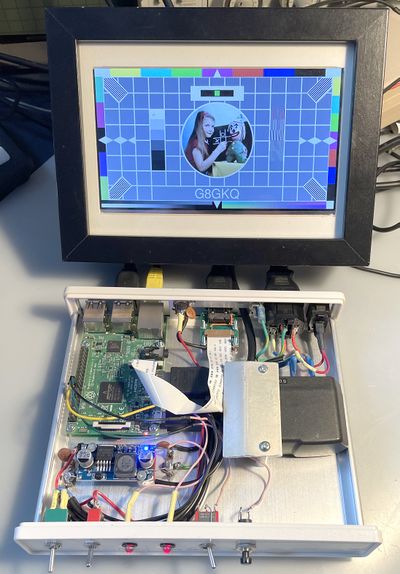BATC HDMI Source
The BATC HDMI Video source is designed to allow selected WebCams and Raspberry Pi Cameras to be used with HDMI-input video mixers. It also provides a source of HDMI Test cards and some HDMI diagnostic information. It is based on a Raspberry Pi 3B, but should work on the Raspberry Pi 2 and 1. It has not been tested on the Raspberry Pi Zero or Raspberry Pi 4.
Construction
The wiring for the HDMI source is very simple; it only requires a switch connected between GPIO pin 16 and ground, and a button connected between GPIO pin 18 and ground. An additional "Active" LED can be wired, with a series resistor, between pin 13 and ground.. A 5.2 volt power supply completes the build. Make sure that you retain access to the HDMI output socket, the LAN port, all 4 USB ports and an extender for the Raspberry Pi Camera ribbon cable if required.
Software Build
The software build is based on the latest Bullseye Lite operating system (not the Buster version used for Portsdown and Ryde). The build process is very similar to that used for the Portsdown and is described here https://github.com/BritishAmateurTelevisionClub/hdmisource.
There is no upgrade process. A new build is required to load any (infrequent) new features.
Operation
On first power-up, make sure that the switch is open (the Test Card position) and that you have the Pi Camera connected if you plan to use it. Hot-plugging of the Pi Camera is not supported. Also connect the display or mixer to the HDMI output so that it can negotiate the correct resolution and frame rate.
Once the Raspberry Pi boots, the first test card should be displayed with a callsign overlay. Each time the button is pressed, the test card should change.
If the switch is closed, the first camera will be selected. The camera order is:
Original (H264-capable) Logitech C920 Polycom Eagleeye USB Webcam EasyCap video composite video Raspberry Pi Camera
Each time the button is pressed, the next camera will be selected. Hot plugging of webcams (but not the Pi Cam) is supported
A long press (2 seconds) of the button will cause the Raspberry Pi to safely shutdown. A caption is displayed, and the "Active" LED (if fitted) will extinguish.
Camera Sources
ONLY the following camera sources are supported. Users will need to modify the file hdmisource/camera.sh if they want to add support for other cameras.
- The early (H264-capable) C920 webcam. The subsequent 2 versions of the C920 are NOT supported.
- The Polycom Eagleeye webcam. Two of these can be connected, and individually selected.
- An Easycap for composite video capture. Both the Portsdown-compatible USBTV-007 version and the non-compatible MS210x versions are supported.
- Raspberry Pi Cameras version 1, 2 and HQ.
Audio
Although planned, there is no audio functionality yet.
Configuration
An SSH Console Menu is available. This allows selection of specific cameras and changing the GPIOs used for the button, switch and LED.
HDMI Utilities
The SSH Console Menu includes the option to list the compatible modes of any conneced HDMI monitor. It also includes the option to check the actual output configuration of the Raspberry Pi HDMI output.
Experimental HDMI Capabilities
It is possible to use the SSH Console Menu to request the Raspberry Pi to reboot into a specific HDMI output mode. Not all of the selections currently work and these can result in a failure to boot, requiring the card to be rebuilt. More testing and guidance to follow.
